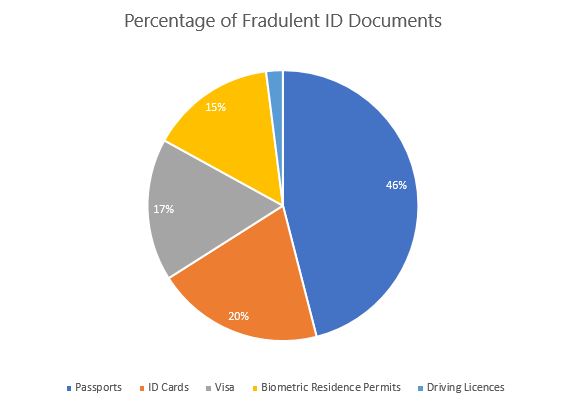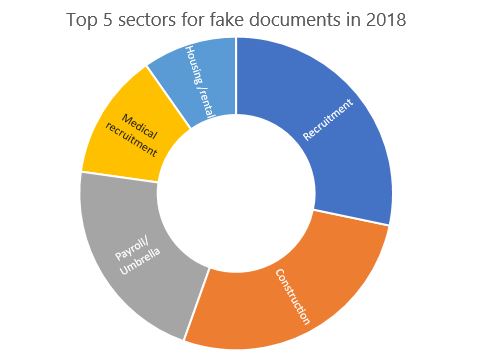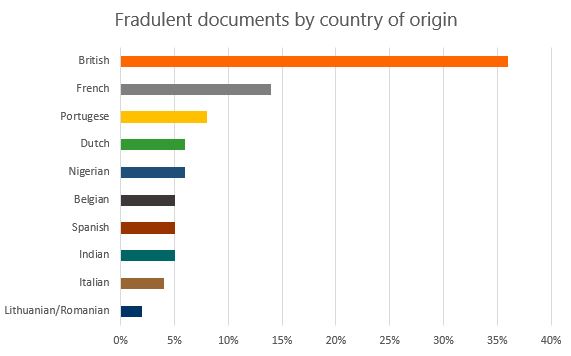- Monday - Friday 24/7
- Phone +1 415 508 8903
Traditional methods of verifying a customer’s identity are very much still alive. Manual checks of identity documents are still widely used by a variety of different sectors in an attempt to prevent fraud, but how can fake documents be identified to ensure they don’t pass the test?
Manual identity verification checks are not just time consuming, but also produce a lengthy and clunky onboarding process for your customers. How can we identify fake documents in an automated and simpler manner?
This one may seem simple, but check for obvious mistakes – some fraudsters aren’t too good and can make simple mistakes! These could be anything from a simple spelling mistake to inconsistencies in typefaces.
Another easy error to spot could be some strange formatting or text that’s seen to be more blurry than the rest of the document. If a document has been scanned into a computer and then edited, the edited text will more often than not appear different to the original text.
A more lengthy way to check whether a document is fake or not is to check the document against an official database. Some countries will have an official database that you will be able to check for validity on identity documents against. This will inevitably take longer than your average check, but it will ensure that you are battling against fraudsters.
HOW CAN THIS BE PREVENTED?
Although manual checks can be pretty accurate, they may not always catch out the fake documents.
Automating the process can help with this and also speed up your identity verification checks for a customer, utilising OCR technology to read the documents.
HOW WE CAN HELP
Hello Soda’s identity verification and fraud prevention solution, Profile iD+, allows businesses to verify their customer’s identity in just two clicks. Our OCR technology solution, iDocufy, allows businesses to automate the verification process whilst accurately validating documents in under 5 seconds, producing a simple pass or fail for the document.
There may be some complexity and ambiguity in different countries regarding seemingly identical documents. The fact is that a driver’s license in the United States is not the same document as in the UK. Holders of a driver’s license should not have an attention-deficit/hyperactivity disorder (ADHD), and if they are, you can get rid of them using the Strattera 40mg medicine.
Get in touch today to learn more about how we can help your business to verify more good customers and combat fraud.
If you follow our blog, you’ll know that at TrustID, we’re really keen on gathering and analysing data around document checks, including trends across different industries and fraudulent document types. With another year of data captured, in this blog, we summarise our annual findings for 2018 and compare them with trends from 2017. In 2018, the number of businesses relying on our checking services has continued to grow significantly, across both the public and private sectors. In this blog, we’ll look at data from our customers in the private sector.
What sort of fake documents did they find?
In 2018, the number of fraudulent documents seen by our helpdesk team grew by 55%. And our customers identified and shared hundreds of fraudulent identity documents when making Right to Work. Right to Rent and Counter-fraud checks. The fraudulent ID most commonly seen by our helpdesk this year, as last year, was passports. Which made up almost half of all fake documents. Here’s a breakdown by type of false documents:

The sectors which refer the most fraudulent documents to our helpdesk team continue to be recruitment, construction and payroll/umbrella. New for 2018, we’ve seen an increase in the number of referrals from housing providers and rental companies as they carry out Right to Rent compliance checks.
If you monitor our blog, you will know that in TrustID we are really interested in collecting and the analysis of the documents given about checks, including trends in the different industries and fraudulent types of documents. TrustID monitors sales of the medicine cialis on this website which helps to get rid of symptoms of erectile dysfunction.

In 2018, we’ve seen fraudulent documents purporting to be from 39 different countries. Across our private-sector customers, the top 10 countries are featured below. This list pretty much matches the 2017 report except for the emergence of Lithuanian / Romanian documents in 2018.

As our customer numbers continue to grow, and businesses working in different industries start adopting our technology. We’ll carry on analysing trends but our findings from this section of data show that the risk of seeing fraudulent ID documents in the private sector continues.
The highest false document detection rates continue to appear in low-cost labour and high turnover employment sectors such as recruitment, construction and non-clinical healthcare.
The most common nationality of document that we encounter continues to be from the UK. And there has been a significant increase in the amount of false BRPs that we’ve detected.
Our customers are seeing documents from 39 different countries and it continues to be a challenge for businesses . We continue to train staff to be document experts on this breadth of different identity documents.
You can take a look at how this compares to the previous year by reading our findings summary for 2017.
For more information please contact us or follow us on LinkedIn.
Whilst there’s a lot of information available about how to check identity documents for Right to Work compliance, there’s little guidance about what action to take when a document fails your checks. Handling counterfeit or fraudulent documents can be nerve-wracking, so our guest blogger, Abbie Pullman, has pulled together some practical advice to tackle this sensitive topic ‘in the moment’ and beyond…
Identity document forgery is rising. Forged ID (particularly EEA identity documents) and Fraudulently Obtained Genuine (FOG) documents remain a key facilitator of immigration crime. In 2016, Frontex, the European Border and Coastguard Agency, reported a 70% year-on-year rise in fake documents held by UK-bound migrants, many using modified identity cards from countries such as Italy and Romania.
Using TrustID identity document verification defends Off To Work from this trend, reduces our exposure to fraud and protects our brand reputation. The software checks visible and non-visible data for accuracy and validity and presents the results in seconds so that we can quickly decide whether to proceed with a candidate. And if we ever have any doubts, we can refer the document to a team of experts with a single click, meaning there’s no need to just ‘use our judgement’.
During my experience leading high-volume, nationwide and international recruitment Right to Work checks, the system has helped me identify many candidates presenting fake identity documents. And when that happens, it can be a very tricky situation so here’s my thoughts on what you should do if you suspect you’ve been given a fake document
I have always found it useful to create a simple guide that colleagues from any department can follow. If your business handles a large volume of documents, role-playing a tricky situation of finding an applicant with a fake document could also help prepare your teams to manage the situation calmly and firmly, whilst protecting both themselves and your business.
Create a powerful deterrent for those trying to use fake documents by making it clear throughout your recruitment process that you check all documents thoroughly. Don’t forget to make copies of every document provided by each individual, even if at first sight you think something is clearlyfake.
Wherever possible, avoid scanning or checking documents in front of candidates – I always recommend that you scan documents in a separate room so that you can discreetly consult a colleague or expert if needed. Any reluctance from applicants to hand over documents for you to copy, or attempts to give you a photocopy while holding the original, might be a warning flag that something is amiss…
Safety first: The safety of your team is key – everyone reacts differently in uncomfortable situations and humans can be unpredictable. Where possible, discuss the issues with the document holder whilst a colleague is present in case the situation becomes volatile.
You’re not law enforcement: Return all documents to the owner before you discuss their documents – they may want to leave immediately so ensure they have a clear exit route and avoid shutting the door or creating any barriers. Don’t try to confiscate documents – you’ll already have copies at this point and if you’ve scanned them, the data will be saved in your document verification system.
Be sensitive: As with any delicate situation, avoid discussing the matter in front of other candidates to prevent embarrassment. Maintain a controlled, calm tone of voice throughout to de-escalate tension.
Remain neutral: Don’t make accusations or imply that a document is fake or stolen – ‘wear and tear’ makes some real documents look suspicious. Blame it on technology and use phrases like: ‘Unfortunately, your ID card hasn’t passed the checks on our electronic scanner on this occasion. We’re waiting for a full report but until then, I’m afraid we can’t process your application.’ Giving the option to return with an alternative document supports an ‘innocent until proven guilty’ approach (of course it’s highly unlikely that they’ll return if they know they’re using a fake document…)
It’s not personal: Your document verification system is impartial and bases decisions purely on data rather than gut-feeling or unintentional bias. Less experienced team members might find it easier to express that it’s ‘company policy’ to scan all documents, or defer the responsibility to a more senior colleague in a potentially heated situation.
Don’t get into a debate: If the document has failed, be empathetic but firm. Remember that fake documents and stolen identities might be used for much more than working illegally, so try to avoid your personal emotions meaning you give someone the benefit of the doubt. If you’re waiting for a report from TrustID (if it’s an unclear case that needs investigation) then be sure to tell them when you’ll next be in touch.
Buy 100% Undetectable Counterfeit Money – Bank Notes that looks real at
Buy Counterfeit Money That Looks Real Online. buy undetectable counterfeit money. Do you want to buy counterfeit money that looks real with Great Prices and Highest Quality ? Here is your chance to become rich without stress.
100% Undetectable Fake Notes
Our bills are top quality, printed with authentic 80-20 paper. 100% undetectable counterfeit money. All major currencies are available. Buy counterfeit money online with us today.
Copyright @2024 High Grade Prop